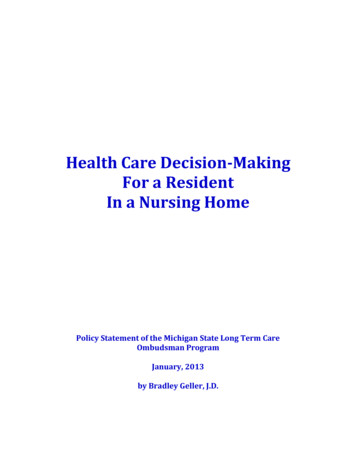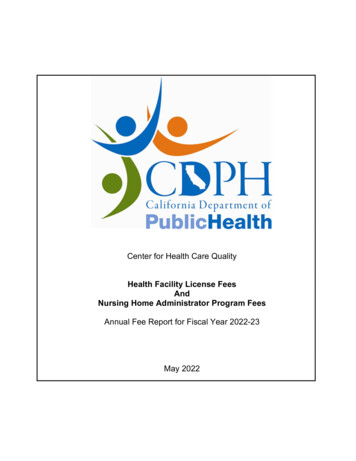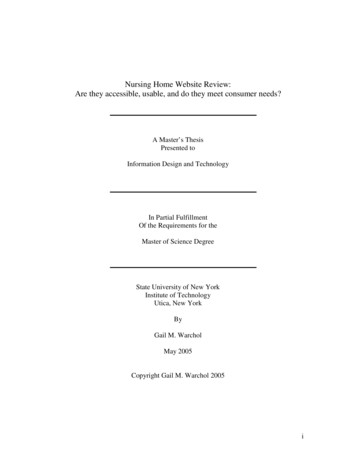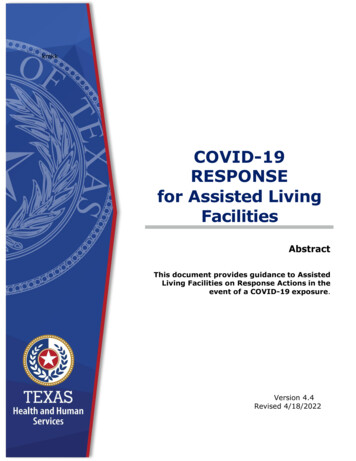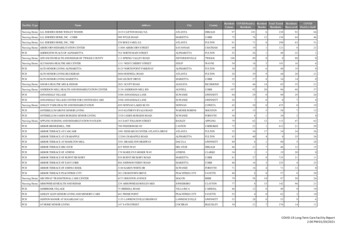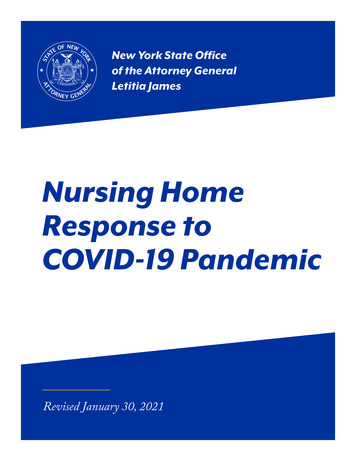
Transcription
New York State Officeof the Attorney GeneralLetitia JamesNursing HomeResponse toCOVID-19 PandemicRevised January 30, 2021
ContentsExecutive Summary. 5Timeline.9Effect on Nursing Home Residents .10A. Facility-Reported Deaths.101. A Larger Number of Nursing Home Residents Died from COVID-19Than Public DOH Data Reflected.102. High Numbers of Deaths at Nursing Homes During the Pandemic ExceededMorgue Capacity and High Volumes of Deaths Citywide Exceeded Capacityof County Medical Examiners and Funeral Homes.12Guidance Issued by Federal and State Governments.13Methodology: Phase One Investigations, Hotline Reports, and Data Analysis.13A. Phase One Investigations of Nursing Homes Conducted by OAGDuring the First Wave of the Pandemic.14B. Attorney General James’ COVID-19 Hotline .14Preliminary Findings from OAG Investigations and Data Analysis. 17A. Lack of Compliance with Infection Control Protocols Put Residentsat Increased Risk of Harm During the COVID-19 Pandemic in Some Facilities. 171. Pre-Existing Infection Control Requirements for Nursing Homes . 172. Health Oversight Agencies Directed Nursing Homes to StrengthenPre-Existing Infection Control Policies at the Onset of the COVID-19 Pandemic.183. Examples of Preliminary Findings Regarding Infection Control Practices.19a. Failure to Isolate COVID-19 Residents Put Residents and Staffat Increased Risk of Harm.20b. Continued Communal Activities, including Communal Dining,Put Residents and Staff at Increased Risk of Harm.21c. Lax Employee Screening Put Residents and Staff at Increased Risk of Harm.21d. DOH Inspections Increased Facility Compliancewith Infection Control Protocols.212
ContentsB. Nursing Homes with Low CMS Staffing Ratings had Higher COVID-19 Fatality Rates. 221. Preliminary Investigative Findings Regarding Low Staffing Levels .242. CMS Staffing Ratings Correlate More Strongly with COVID-19 Death Ratesthan CMS Overall Ratings.28a. The Majority of the COVID-19 Reported Nursing HomeDeaths Occurred in CMS 1-Star and 2-Star Staffing Rated Homes.29b. Staffing Was More Determinative of Death RatesThan “COVID-19 Geography” During Initial Wave of the Pandemic. 30C. Lack of Sufficient PPE for Nursing Home Staff Put Residents at Increased Riskof Harm During the COVID-19 Pandemic in Some Facilities. 31D. Lack of COVID-19 Testing for Residents and Staff in Early Stagesof the Pandemic Put Residents at Increased Risk of Harm in Many Facilities. 331. Testing Requirements Helped Facilities Identify Residents andStaff Who Were Infected with COVID-19.352. DOH Testing Protected Residents.35E. Lack of Nursing Home Compliance with Executive Order RequiringCommunications with Family Members Caused Avoidable Pain and Distress. 36F. Government Issued Guidance May Have Led to an Increased Risk to Residentsin Some Facilities and May Have Obscured the Data Available to Assess that Risk. 361. At Least 4,000 Nursing Home Residents Died After the March 25Guidance on Admission Practices.362. DOH’s March 21 Guidance on Testing Practices Obscured the Data.38G. Immunity Provisions May Have Allowed Facilitiesto Make Financially-Motivated Decisions.38H. Ongoing Investigative Work. 423
ContentsRegulatory Framework.43A. New York State Law on Nursing Home Requirements to Provide Careand Staffing to Meet Resident Needs. 43B. New York State Law on Nursing Home Duties to Residents. 43C. Federal Law Relating to Nursing Homes.441. Federal Law for Nursing Homes Especially Pertinent to the COVID-19 Pandemic.452. 2019 Changes to Federal Nursing Home Regulations. 463. CMS’s 2019 Proposed Changes to Nursing Home Regulations. 46Recommendations. 48Conclusion.52Acknowledgments & MFCU Mission Statement.52Appendix.53Appendix A: Table of Key Federal and State Guidance. 53Appendix B: An Illustration of the Too Prevalent “Low Staffing for Profit” Modelof Exploitation Through Insufficient Staffing, Lack of Transparencyand Financial Incentives: a Pre-Pandemic MFCU Investigation,Findings and Prosecution. 634
Executive SummaryThis report is based on preliminary findings of the Office of Attorney General Letitia James (OAG)1 froma review of information available through November 16, 2020. The report includes facts from the OAG’spreliminary investigations of allegations of COVID-19-related neglect of nursing home residents acrossNew York state and health data maintained as a matter of law by nursing homes and the New York StateDepartment of Health (DOH).In early March,2 OAG received and began to investigate allegations of COVID-19-related neglect of residents innursing homes. On April 23, OAG set up a hotline to receive complaints relating to communications by nursinghomes with family members prohibited from in-person visits to nursing homes.3 OAG received 774 complaintson the hotline through August 3 (an additional 179 complaints were received through November 16). OAGalso continued to receive allegations of COVID-19-related neglect of residents through pre-existing reportingsystems. During this time, OAG received complaints regarding nursing homes across the state, with a greatervolume of complaints regarding nursing homes in geographic areas with higher rates of community-basedtransmission of COVID-19.OAG is conducting ongoing investigations into more than 20 nursing homes across the state whose reportedconduct during the first wave of the pandemic presented particular concern. Other law enforcement agenciesalso have ongoing investigations relating to nursing homes. Under normal circumstances, OAG would issue areport with findings and recommendations after its investigations and enforcement activities are completed.However, circumstances are far from normal. DOH data reports over 6,645 resident deaths as of November16, with the vast majority (over 6,420) of those deaths occurring as of August 3. The COVID-19 health crisis iscontinuing and projected to worsen in the coming winter months. Infection rates are rising across the state,and across states nationwide, following increased travel and social gatherings over the holiday season.Inconsistent public compliance with face mask wearing, social distancing, and hand washing persists —despite orders and scientific guidance that shows these practices reduce the risk of COVID-19. Under thesecircumstances, nursing home residents remain especially vulnerable to transmission of COVID-19.Attorney General James is issuing this report including findings based on data obtained in investigationsconducted to date, recommendations that are based on those findings, related findings in pre-pandemicinvestigations of nursing homes in New York, and other available data and analysis thereof. Attorney GeneralJames offers this information to the public in the interest of increasing transparency and awareness andencouraging collective action by our state’s residents to protect each other and our state’s vulnerable nursinghome residents. In addition, this information may be useful to other decision-makers for their considerationas they continue to respond to the ongoing pandemic.5
OAG’s preliminary findings are:» A larger number of nursing home residents died from COVID-19 than DOH data reflected.» Lack of compliance with infection control protocols put residents at increased risk of harm duringthe COVID-19 pandemic in some facilities.» Nursing homes that entered the pandemic with low U.S. Centers for Medicaid and Medicare Services(CMS) Staffing ratings4 had higher COVID-19 fatality rates than facilities with higher CMS Staffing ratings.» Insufficient personal protective equipment (PPE) for nursing home staff put residents at increasedrisk of harm during the COVID-19 pandemic in some facilities.» Insufficient COVID-19 testing for residents and staff in the early stages of the pandemic put residentsat increased risk of harm in some facilities.» The current state reimbursement model for nursing homes gives a financial incentive to ownersof for-profit nursing homes to transfer funds to related parties (ultimately increasing their own profit)instead of investing in higher levels of staffing and PPE.» Lack of nursing home compliance with the executive order requiring communication with familymembers caused avoidable pain and distress; and,» Government guidance requiring the admission of COVID-19 patients into nursing homes may haveput residents at increased risk of harm in some facilities and may have obscured the data availableto assess that risk.To address the report’s findings, a summary of recommendations follows below.6
Recommendations:» Ensure public reporting by each nursing home as to the number of COVID-19 deaths of residentsoccurring at the facility — and those that occur during or after hospitalization of the residents— in a manner that avoids creating a double-counting of resident deaths at hospitals in reported stateCOVID-19 death statistics.» Enforce, without exception, New York state law requiring nursing homes to provide adequate careand treatment of nursing home residents during times of emergency.» Require nursing homes to comply with labor practices that prevent nursing homes from pressuringemployees to work while they have COVID-19 infection or symptoms, while ensuring nursing homes obtainand provide adequate staffing levels to care for residents’ needs.» Require direct care and supervision staffing levels that (1) are expressed in ratios of residents to RegisteredNurses, Licensed Practical Nurses, and Certified Nursing Assistants; (2) require calculation of sufficiencythat includes adjustment based on average resident acuity; (3) are above the current level reflectedat facilities with low CMS Staffing ratings; and, (4) are sufficient to care for the facility’s residents’ needsreflected in their care plans.» Require additional and enforceable transparency in the operation of for-profit nursing homes, includingfinancial transactions and financial relationships between nursing home operators and related parties,and relatives of all individual owners and officers of such entities with contractual or investorrelationships with the nursing home. Through a variety of related party transactions and relationships,owners and investors of for-profit nursing homes can exert control over the facility’s operationsin a manner that extracts significant profit for them, while leaving the facility with insufficient staffingand resources to provide the care that residents deserve.» Ensure that nursing homes invest sufficiently in effective training so staff can fully comply with infectioncontrol protocols. Hold operators accountable for failure to have clinically appropriate policies in placeand to effectively train staff to comply with them.» Support manufacturing of PPE to facilitate sufficient supply of PPE for purchase by nursing homes.Enforce requirements that nursing homes have sufficient inventory of PPE for all staff to be ableto follow infection control protocols.» Ensure that adequate COVID-19 testing is available to nursing home residents and employees and enforcerequirements that nursing homes test residents and staff in accordance with DOH and the Centersfor Disease Control and Prevention (CDC) evidence-based guidelines.7
» Eliminate the recently enacted immunity provisions that can provide financial incentives to for-profitnursing home operators to put residents at risk of harm by refraining from investing public funds to obtainsufficient staffing to meet residents’ care needs, to purchase sufficient PPE for staff, and to provideeffective training to staff to comply with infection control protocols during pandemics and other publichealth emergencies.5» Formally enact and continue to enforce regulatory requirements that nursing homes communicatewith family members of residents promptly, but not later than within 24 hours of any confirmedor suspected COVID-19 infection and of any confirmed or suspected COVID-19 death.» Increase staffing at DOH to ensure sufficient skilled resources for oversight, complaint assessment,surveys, inspections, and immediate responses to information requests from state agencies in supportof health care and law enforcement efforts.» Ensure that nursing homes engage in thoughtful planning regarding post-mortem care needs andimplement and train staff on policies for dignified care of the remains of deceased residents.» Urge families to consult the CMS Care Compare online database (medicare.gov/care-compare),ask questions of nursing homes relating to staffing, policies, procedures, and recent and current COVID-19infections of staff and residents, and to obtain information relevant to their current or future long-termcare decisions for their loved ones. Where possible, visit family member residents in person and through“window” visits and videocalls even if resident is unable to communicate, to provide emotional supportand to enable observation of the resident’s physical appearance and condition. Ensure family membersknow to report suspected neglect or abuse to DOH and OAG.8
TimelineOn January 31, the Secretary of the U.S. Department of Health and Human Services (HHS) declared a publichealth emergency for the United States to aid the nation’s health care community in responding to COVID-19.The emergency declaration gave state, tribal, and local health departments more flexibility to request that HHSauthorize them to temporarily reassign personnel to respond to COVID-19.6 While everyone is at risk of gettingCOVID-19, older adults and people of any age who have serious underlying medical conditions are at higher riskfor more severe illness. In early February, DOH issued specific correspondence to health care facilities in New Yorkdirecting them to plan for COVID-19. In early March, travel-related cases and community contact transmissionsof COVID-19 were documented in New York. On March 7, Governor Andrew Cuomo declared a COVID-19 DisasterEmergency, declaring that a “disaster is impending in New York State, for which the affected local governmentsare unable to respond adequately.”New York took the brunt of the initial wave of COVID-19 infections from March through May, as reflected inthe high number of COVID-19 infections and deaths. As reported in numerous sources, the New York Citymetropolitan area received the bulk of travelers from Europe prior to federal closure of international airports.From March through August 3, DOH reported a total of 6,423 resident deaths in nursing homes due to COVID-19,including 3,640 confirmed COVID-19 deaths and 2,783 presumed7 COVID-19 deaths.8 These reported deaths arebased on data reported by New York’s 619 nursing homes to DOH through its Health Emergency Response DataSystem (HERDS). As reported by The New York Times, there were 422,296 COVID-19 infections and 32,422 COVID-19deaths in New York state as of August 4:99
Effect on Nursing Home ResidentsA. Facility-Reported DeathsIn New York state, the first wave of the COVID-19 pandemic impacted many of the residents and staff of the 304nursing homes located within the nine downstate counties in the New York City metropolitan area.10 Within thesecounties, according to DOH, there were 2,567 confirmed COVID-19 resident deaths and 2,687 presumed COVID-19resident deaths, for a total of 5,254 resident deaths in nursing homes from March through August 3. Of the total6,423 reported resident deaths in nursing homes statewide as of August 3, 81 percent occurred in facilities inthese nine downstate counties. (Through November 16, reports total 6,645 resident deaths due to COVID-19.)Western, Northern, and Central New York also experienced COVID-19 infections in nursing homes during thistime. According to DOH, from March through August 3, nursing homes upstate reported 1,169 resident deaths,including 1,073 confirmed COVID-19 deaths and 96 presumed COVID-19 deaths. The state’s peak of nursing homeresident COVID-19 reported deaths occurred on April 8.111. A Larger Number of Nursing Home Residents Died from COVID-19 Than Public DOH Data ReflectedPreliminary data analysis obtained from OAG inquiries to a portion of nursing homes duringthe pandemic suggests that many residents died from COVID-19 in hospitals after being transferredfrom their nursing homes.OAG asked 62 nursing homes for information about on-site and in-hospital deaths from COVID-19 for theweek of March 1 to the date of the facility’s response, which varied from the week of April 12 to July 19. Thissample of facilities – approximately 10 percent of the number of nursing homes in New York – was notrandomly selected. OAG investigation teams requested data regarding resident deaths during the courseof its preliminary investigations.12Using the data from these 62 nursing homes, OAG compared: (1) in-facility deaths reported to OAGto in-facility deaths publicized by DOH, and (2) total deaths reported to OAG to total deaths publicizedby DOH.13The first comparison raised some questions, as shown on the chart below:Deaths at Facilities – Comparison of Reports to OAG and DOHFacility Deaths Reported to OAG1,266Facility Deaths Publicized by DOH1,229Difference(37)Over/Under Percentage-3.01%10
Although the calculated discrepancy of 3.01 percent may seem relatively low under the circumstances,closer analysis revealed that some facilities reported the location of the person at the time of deathinconsistently. The discrepancies raise concerns because, when the data is removed for seven facilities thatreported differing locations of death yet had a consistent total death count, the difference in reportingof deaths at the remaining 55 facilities jumps as publicized by DOH to 18.66 percent. The DOH reportingsystem explicitly requires facilities to correct inaccurate reporting. Either such correction was not made by anumber of facilities, or data were not reflected in DOH’s published data for other reasons.Total Deaths Reported to OAG (incl. residents sent to hospitals) vs. Publicized by DOHFacility Deaths Reported to OAG1,914Total Deaths Publicized by DOH1,229Difference(685)Over/Under Percentage-55.74%The examples below illustrate that discrepancies remain even when the data reported to OAG is comparedto data published by DOH as of later time periods through August 3:» A facility reported 11 confirmed COVID-19 deaths at the facility, one suspected COVID-19 death atthe facility, and four hospital deaths to DOH as of May 2020, and reported the same data to OAG.However, DOH published only one confirmed COVID-19 death at the facility until July 31, when itspublication reflected eleven confirmed in-facility deaths -- a discrepancy of five deaths from whatwas reported to DOH by the facility. 14» A facility reported one confirmed and six presumed COVID-19 deaths at the facility as of August 3to DOH. However, the facility reported to OAG a total of 31 COVID-19 suspected deaths at the facilityas of April 18 – a discrepancy of 25 deaths.» A facility reported five confirmed and six presumed COVID-19 deaths at the facility as of August 3to DOH. However, the facility reported to OAG a total of 27 COVID-19 deaths at the facilityand 13 hospital deaths – a discrepancy of 29 deaths.Applying the data that these 62 nursing homes reported to OAG, which includes resident deaths occurringin the facility and in the hospital after transfer, shows a significantly higher number of resident COVID-19deaths can be identified than is reflected in the deaths publicized by DOH.11
OAG is investigating those circumstances where the discrepancies cannot reasonably be accountedfor by error or the difference in the question posed.In conclusion, this preliminary data for the 62 facilities and time periods noted above suggests that COVID-19resident deaths associated with nursing homes in New York state appear to be undercounted by DOHby approximately 50 percent. 152. High Numbers of Deaths at Nursing Homes During the Pandemic Exceeded Morgue Capacity andHigh Volumes of Deaths Citywide Exceeded Capacity of County Medical Examiners and Funeral HomesOAG preliminary investigations indicate that in April, six New York City nursing homes experienced residentdeath numbers that exceeded the facilities’ onsite morgue capacity. In each of those instances, the facilityappropriately contacted funeral homes or the medical examiner’s office. However, the high numbersof COVID-19 deaths across New York City had filled the capacity of local medical examiners and funeralhomes. As a result, there were times when several days passed before remains could be transported out ofthe facilities.16 Media reports in New York City during the peak of the first wave of the pandemic containedallegations that bodies of deceased residents were “piling up”17 18 inside a number of nursing homes.OAG investigated these allegations.OAG determined that the allegations were unfounded with respect to two of the six nursing homes. Inthree for-profit facilities, OAG determined that the remains awaiting transfer were stored in accordancewith accepted industry practice, which is to place the bodies in unoccupied patient rooms with the airconditioning on full power and with doors sealed. In an investigation of one not-for-profit facility, OAGdetermined that deceased residents’ bodies awaiting transfer were appropriately stored in rentedrefrigerated trucks in the parking lot of the facility.Under the circumstances, the preliminary investigations indicate no violation of law or industry practice inthe storage of the remains of deceased residents. These incidents raise the question of whether the facilitiesengaged in enough planning. Relatedly, some staff conveyed surprise and shock at the discovery of onsitestorage of remains other than in the morgue, indicating internal communication and training lapses.12
Guidance Issued by Federal and State GovernmentsFederal and state agencies issued and updated guidance from January to May as evidence and knowledgeabout COVID-19 developed. During the pandemic, Governor Cuomo issued many executive orders in an effortto flatten the rising curves of COVID-19 infection and death rates, including directing New York to be “On Pause,”and requiring the public to wear masks and practice social distancing. In addition, CDC, CMS, and DOH issuedguidance relative to COVID-19. As the virus spread through New York and other states and countries, moreinformation was promulgated about COVID-19 infection, illness, and treatment, prompting federal and statehealth agencies to issue updated guidance. Much of this information contained reminders and updates aboutbest practices for containment and control of respiratory viruses – a disease vector well understood in healthcare facilities. This guidance also reflected updates on evolving medical knowledge about COVID-19.A chronology of key guidance and directives issued by CDC, CMS, DOH, and Governor Cuomo that relatesto nursing homes appears in the table in Appendix A.***With these health care directives as background, OAG conducted the investigations described in the followingsections.Methodology: Phase One Investigations, Hotline Reports,and Data AnalysisOAG used three investigative approaches for this report. First, OAG opened a hotline to receive reports ofviolations of executive orders concerning communications with families, which expanded to receive reportsof abuse and neglect. Second, OAG analyzed data from CMS and DOH for correlations between COVID-19outcomes and CMS facility ratings. Third, OAG followed up on direct or media reports of potential abuse orneglect due to COVID-19. OAG conducted preliminary, or phase one, investigations of many nursing homes,and has continued and expanded investigations with respect to a number of them.Except where noted, this preliminary report excludes information from enforcement investigations, and, wheresuch information is set out, portions were redacted or paraphrased to protect the investigation or privacy ofindividuals not accused of wrongdoing. Names of individuals or business entities have been redacted, unlessthe person was convicted of criminal conduct or named in public filings such as settlement agreements orAssurances of Discontinuance under Executive Law § 63(12).13
A. Phase One Investigations of Nursing Homes Conducted by OAG Duringthe First Wave of the PandemicBased on allegations of COVID-19 related neglect received as of August 9, OAG conducted phase oneinvestigations into 174 nursing homes statewide. Preliminary findings in this report are based on informationobtained in the investigations, and the other data referenced herein. The data obtained during theseinvestigations includes interviews conducted by telephone, documents obtained from nursing homesand third parties, and surveillance conducted. These complaints and investigations included facilitieseverywhere in the state. Based on the preliminary investigations, OAG is continuing investigations of over20 facilities in greater depth.Upon receipt of these allegations, OAG investigative teams followed up with complainants and promptlycontacted the nursing home in question to determine whether substandard infection prevention and controlpractices existed at the reported home that could endanger residents, or if critically low staffing existed tothe same effect. In the vast majority of these instances, the subject nursing homes cooperated fully. The primarygoal of the initial inquiries was to determine whether, among other things, each facility reported having PPEand proper infection control protocols in place, and whether, based on the staffing and other conditionsreported, the residents appeared to be in danger. If OAG concluded that alleged circumstances at a facilitypresented likely and significant risks of harm to the residents, OAG referred those facilities to DOH for immediateaction. DOH responded to such facilities, including with onsite teams. A DOH referral does not mean thatOAG closed its own investigation.B. Attorney General James’ COVID-19 HotlineOAG opened a dedicated internet and telephone hotline on April 23, to address public and inter-agencyconcerns about a lack of prompt and effective compliance with Executive Orders 202.18 (April 16) and 202.19(April 17) concerning communications with family members. The executive orders require nursing homes andassisted living facilities to notify “family members or next of kin of residents” within 24 hours when a residentof the facility either tests positive for COVID-19 or suffers a COVID-19-rel
» A larger number of nursing home residents died from COVID-19 than DOH data reflected. » Lack of compliance with infection control protocols put residents at increased risk of harm during the COVID-19 pandemic in some facilities. » Nursing homes that entered the pandemic with low U.S. Centers for Medicaid and Medicare Services






